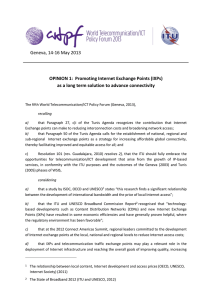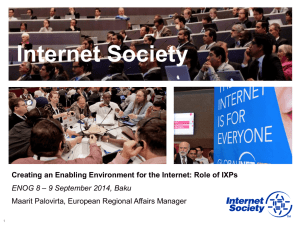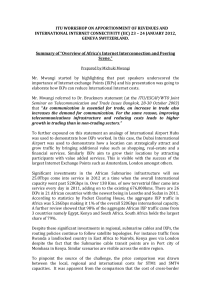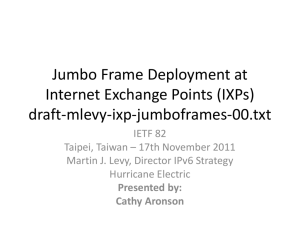Executive Director’s Office PO Box 29755, Melville, 2109, South Africa
advertisement
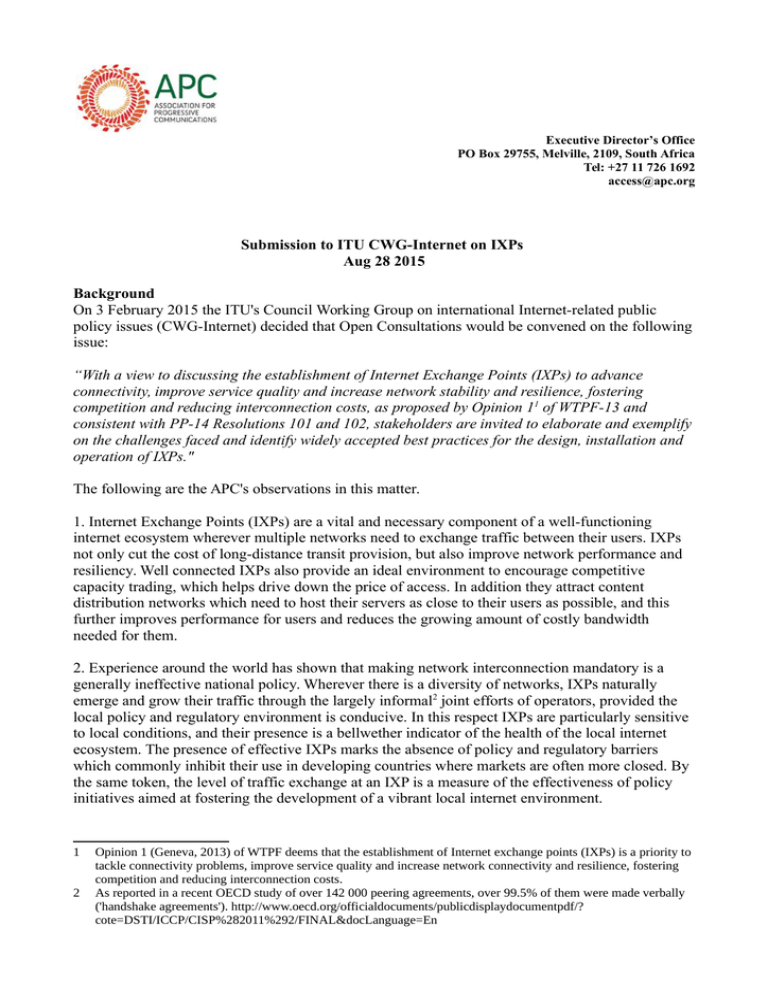
Executive Director’s Office
PO Box 29755, Melville, 2109, South Africa
Tel: +27 11 726 1692
access@apc.org
Submission to ITU CWG-Internet on IXPs
Aug 28 2015
Background
On 3 February 2015 the ITU's Council Working Group on international Internet-related public
policy issues (CWG-Internet) decided that Open Consultations would be convened on the following
issue:
“With a view to discussing the establishment of Internet Exchange Points (IXPs) to advance
connectivity, improve service quality and increase network stability and resilience, fostering
competition and reducing interconnection costs, as proposed by Opinion 11 of WTPF-13 and
consistent with PP-14 Resolutions 101 and 102, stakeholders are invited to elaborate and exemplify
on the challenges faced and identify widely accepted best practices for the design, installation and
operation of IXPs."
The following are the APC's observations in this matter.
1. Internet Exchange Points (IXPs) are a vital and necessary component of a well-functioning
internet ecosystem wherever multiple networks need to exchange traffic between their users. IXPs
not only cut the cost of long-distance transit provision, but also improve network performance and
resiliency. Well connected IXPs also provide an ideal environment to encourage competitive
capacity trading, which helps drive down the price of access. In addition they attract content
distribution networks which need to host their servers as close to their users as possible, and this
further improves performance for users and reduces the growing amount of costly bandwidth
needed for them.
2. Experience around the world has shown that making network interconnection mandatory is a
generally ineffective national policy. Wherever there is a diversity of networks, IXPs naturally
emerge and grow their traffic through the largely informal2 joint efforts of operators, provided the
local policy and regulatory environment is conducive. In this respect IXPs are particularly sensitive
to local conditions, and their presence is a bellwether indicator of the health of the local internet
ecosystem. The presence of effective IXPs marks the absence of policy and regulatory barriers
which commonly inhibit their use in developing countries where markets are often more closed. By
the same token, the level of traffic exchange at an IXP is a measure of the effectiveness of policy
initiatives aimed at fostering the development of a vibrant local internet environment.
1
2
Opinion 1 (Geneva, 2013) of WTPF deems that the establishment of Internet exchange points (IXPs) is a priority to
tackle connectivity problems, improve service quality and increase network connectivity and resilience, fostering
competition and reducing interconnection costs.
As reported in a recent OECD study of over 142 000 peering agreements, over 99.5% of them were made verbally
('handshake agreements'). http://www.oecd.org/officialdocuments/publicdisplaydocumentpdf/?
cote=DSTI/ICCP/CISP%282011%292/FINAL&docLanguage=En
3. Therefore, in the absence of IXPs, instead of investing large sums in setting them up, in the
expectation that operators will join, or directly mandating networks to interconnect, this should
rather be seen as an indication of a generally unsatisfactory internet ecosystem which needs
addressing through broader policy changes. In the same vein, low levels of traffic at an IXP are
usually an indication of a market problem, such as the dominance of a particular operator in the
market, or high costs of leasing circuits to connect to the exchange.
4. Similarly, little can be done through direct state intervention to set up regional IXPs (often an
attractive political goal) because these naturally emerge where an open policy environment has
combined with geography to create locations where there is high traffic demand from the many
different fibre backbones that can be interconnected at those special locations.
5. Thus, the most effective action Member States can take to foster the emergence of local, national
and regional IXPs is to provide an open, competitive and transparent policy environment for
networks to emerge and grow. This primarily means:
A) Low barriers to entry for operator licenses and access to spectrum, including tiered licensing
regimes for operators with smaller geographic scope than entire countries
B) Unified technology-neutral licensing regimes which allow operators to self provide
infrastructure at international, national and local levels, using a mix of different technologies
that suits their needs
C) Absence of licensing requirements for IXPs as well as for foreign networks and content
providers wishing to be present at IXPs (where they only trade with locally licensed
operators anyway)
D) Regulations which encourage sharing of passive infrastructure, thereby reducing capital and
operational costs for networks by providing non-discriminatory access to towers or high
buildings and ducts or fibre in roads, electricity grids, rail lines and fuel pipelines
E) State support for public access facilities and locally owned networks to meet end-user
demand amongst marginalised communities
F) Encouragement for local applications and content development, including state investment
in e-government services
G) Absence of luxury taxes and import duties on ICT goods and services, which add to costs
and inhibit network use
H) A legislative environment which provides guarantees against surveillance and monitoring
while ensuring network neutrality and online protection for women and children, other
minority groups and intermediaries – aside from the obvious importance of upholding
human rights, the chilling effects on network-use and traffic exchange that can be caused by
the absence of these protections is eliminated
I) The existence of a national multi-stakeholder mechanism that sets out clear principles and
procedures for internet public policy-making which is grounded in human rights standards
and the principle of supporting the public interest.
6. Aside from addressing the need for an enabling policy and regulatory environment, there is also a
need for awareness raising and human capacity development to ensure the potential for rapid
emergence of IXPs and to maximise their impact when they are in place. The major requirements
here are:
Policy makers and regulators need to fully understand the role of IXPs and what policy
changes are needed to the communications market which will lead to a more vibrant local
internet ecosystem and thus ultimately to the growth of IXPs
Network operators need to understand the value in the improved performance and reduced
costs that can be achieved through peering as much traffic as possible through the local
exchange
Network operators need technical staff that understand how IXPs function and how to
implement BGP with multi-path routing – e.g obtaining AS Numbers and configuring
routers. Technical training for network operators is readily available from many in the
technical community such as the Regional Internet Registries (AfriNIC/APNIC etc), ISOC,
PCH and others.
IXPs need managers that understand how to design facilities and membership policies that
can scale to maximise future traffic exchange while ensuring sustainability and reliability.
The international community needs to be aware of ongoing activities to build IXPs and to
understand the most effective means to encourage their emergence through supporting the
development of a broad enabling policy and regulatory environment for the adoption of
ICTs.
The awareness raising and capacity building activities described above are best carried out as
collaborative efforts between all the stakeholders, and can be triggered by specific local or regional
events related to the development of improved ICT infrastructure or policy development. In many
cases capacity building activities can be cost-effectively 'piggy-backed' on these events. Examples
of these include:
Global events such as the Best Practice Forum on IXPs at the Internet Governance Forum
IGF), the ITU's various Regulatory Symposia and Exhibitions, the ISOC's Peering and
Interconnection Fora (PIF)
Regional economic community initiatives that support regional integration and policy
harmonization such as those of the African Union, ECOWAS, SADC and EAC in Africa,
CELAC in Latin America and ASEAN in Asia
Development assistance activities such as those carried out by the World Bank, the Asian
Development Bank, the Inter-American Development Bank and the African Development
Bank, as well as the bilateral development assistance agencies of most developed countries.
The many national ICT exhibitions and events organized by both the government, NGOs
and the private sector.
